The term “workaholic” refers to a person with work addiction. They are affected by a complex mental condition known as workaholism, which makes them work compulsively, even when they don’t enjoy the work process.
What Does “Workaholic” Mean?
A workaholic is someone who is extremely involved in their work and finds it difficult to detach themselves from their work psychologically [mfn] Taris, T. W., van Beek, I., & Schaufeli, W. B. (2020). The Motivational Make-Up of Workaholism and Work Engagement: A Longitudinal Study on Need Satisfaction, Motivation, and Heavy Work Investment. Frontiers in psychology, 11, 1419. https://doi.org/10.3389/fpsyg.2020.01419 [/mfn] and emotionally. They are typically addicted to work and may even choose to work at odd hours by sacrificing other crucial tasks or their personal lives. Not only do they work long hours and late nights, they feel compelled [mfn] Langseth-Eide B. (2019). It’s Been a Hard Day’s Night and I’ve Been Working Like a Dog: Workaholism and Work Engagement in the JD-R Model. Frontiers in psychology, 10, 1444. https://doi.org/10.3389/fpsyg.2019.01444 [/mfn] to do more than necessary by investing their personal time into work.
Although it may seem that a person with workaholism enjoys their work, it is more like an unhealthy obsession rather than having a passion for work. According to a 2018 study [mfn] Lior, O., Abira, R., & Aviv, W. (2018). Work addiction: An organizational behavior as well as an addictive behavior?. Journal of behavioral addictions, 7(4), 888–891. https://doi.org/10.1556/2006.7.2018.119 [/mfn], a workaholic is a person “who is highly work-involved, feels driven to work because of inner pressures, and is low in work enjoyment.” However, some researchers tend to believe that workaholics can enjoy “the act of working” even if they are “obsessed with working.”
Their compulsive need to work is primarily triggered by internal feelings as they tend to have intrusive thoughts when they are not working. Unlike others, they find it challenging not to work and frequently go beyond the reasonable expectations from an employee or worker, even if they have to ignore other commitments [mfn] Hu, Lin. (2018). A Review of Workaholism and Prospects. Open Journal of Social Sciences. 06. 318-334. 10.4236/jss.2018.611024. [/mfn] like health, family and relationships.
Similar to an alcoholic, a workaholic lacks control over their addictive behavior [mfn] Elowe J. (2010). Boulomanie: entre illusion et addiction [Workaholism: between illusion and addiction]. L’Encephale, 36(4), 285–293. https://doi.org/10.1016/j.encep.2009.12.002 [/mfn] and their need to work. They typically reach early to work and are often the last to leave. Not only do they have difficulty relaxing, they may also ignore their personal needs, physical and mental health, social life and relationships for work. One of the primary characteristics of a workaholic is that they often tend to neglect their family and friends for their work. They also tend to –
- Be highly driven, competitive and energetic
- Have no distinction between work and pleasure
- Work from anywhere and anytime
- Prefer to work during their time off
- Work for extremely long hours
- Constantly think about work
- Lack work enjoyment
- Have poor physical and mental health [mfn] Andreassen, C. S., Griffiths, M. D., Sinha, R., Hetland, J., & Pallesen, S. (2016). The Relationships between Workaholism and Symptoms of Psychiatric Disorders: A Large-Scale Cross-Sectional Study. PloS one, 11(5), e0152978. https://doi.org/10.1371/journal.pone.0152978 [/mfn]
- Have low self-esteem and self-doubts
- Experience high levels of stress, anxiety, chronic fatigue [mfn] Andreassen, C. S., Pallesen, S., & Torsheim, T. (2018). Workaholism as a Mediator between Work-Related Stressors and Health Outcomes. International journal of environmental research and public health, 15(1), 73. https://doi.org/10.3390/ijerph15010073 [/mfn], sleep problems, obsessive-compulsive disorder (OCD) etc.
- Experience work-family conflicts
- Have low life satisfaction
Although workaholism is mostly observed in people with paying jobs, the phenomenon can also be present in people pursuing art, music, dance, sports etc.
Read More About Obsessive-Compulsive Disorder (OCD) Here
Understanding A Workaholic Person
Workaholism is a very common behavioral disorder that affects between 27% and 30% of the general population. Coined by psychologist Wayne Oates in 1971, workaholism refers to “addiction to work, the compulsive and uncontrollable need to work incessantly.” Although it is not officially recognized [mfn] Sussman S. (2018). Ten myths (or facts?) about workaholism: An appetitive motivation framework. Journal of behavioral addictions, 7(4), 884–887. https://doi.org/10.1556/2006.7.2018.120 [/mfn], it is a serious psychological condition with real adverse effects. People with this chronic and progressive condition tend to be mentally, emotionally & socially dependent on their work.
A person with workaholism is not similar to someone who works hard to succeed. While a hard working person knows how to detach from their work when they are away from their workplace, a workaholic may remain psychologically and emotionally attached to their work even when they are at home.
The primary difference between hard work and work addiction can be understood by analyzing behavior and mindset. Behavior and action, for instance working late nights, can be associated with hard work and passion; but mentality, such as compulsion to work is associated with work addiction and obsession.
Hence, a workaholic can feel guilty when not involved in work and may put self-imposed pressure on themselves to meet self-created deadlines. They often experience chronic stress, rumination, anxiety [mfn] Serrano-Fernández, M. J., Boada-Grau, J., Boada-Cuerva, M., & Vigil-Colet, A. (2021). Work addiction as a predictor of anxiety and depression. Work (Reading, Mass.), 68(3), 779–788. https://doi.org/10.3233/WOR-203411 [/mfn], insomnia, elevated blood pressure and even depression, which, ironically, affects their work performance.
However, as our society and most work cultures consider hard work or over-work as a sign of dedication and success, such damaging behavior is not stigmatized and mostly goes unrecognized.
Types Of Workaholics
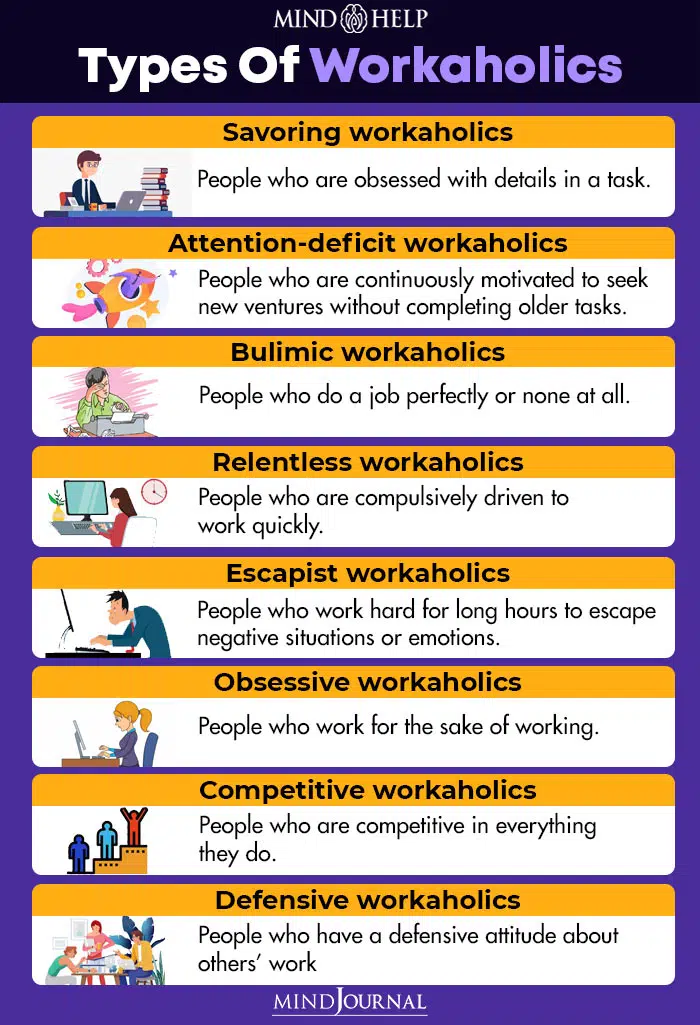
A workaholic usually shows higher levels of work drive [mfn] Avanzi, Lorenzo & Perinelli, Enrico & Vignoli, Michela & Junker, Nina & Balducci, Cristian. (2020). Unravelling Work Drive: A Comparison between Workaholism and Overcommitment. International Journal of Environmental Research and Public Health. 17. 5755. 10.3390/ijerph17165755. [/mfn] and work involvement, more than what is needed. But, they experience low job enjoyment, as they work out of compulsion, not passion. Based on their traits of working, people addicted to work can be categorized as:
- Savoring workaholics – People who are obsessed with details in a task.
- Attention-deficit workaholics – People who are continuously motivated to seek new ventures without completing older tasks.
- Bulimic workaholics – People who do a job perfectly or none at all.
- Relentless workaholics – People who are compulsively driven to work quickly.
- Escapist workaholics – People who work hard for long hours to escape negative situations or emotions.
- Obsessive workaholics – People who work for the sake of working.
- Competitive workaholics – People who are competitive in everything they do.
- Defensive workaholics – People who have a defensive attitude about others’ work
Symptoms Of A Workaholic
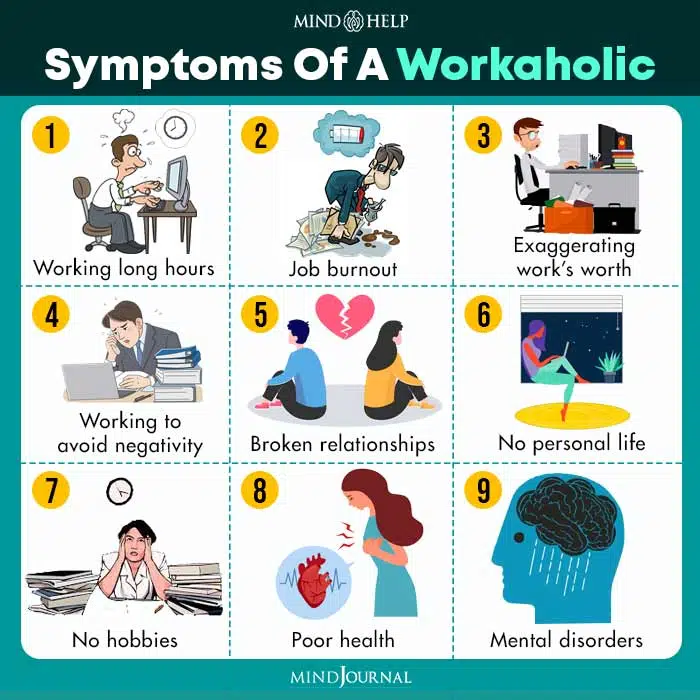
The symptoms of workaholism are similar to other behavioral addictions. The common signs and symptoms of a workaholic involve:
- Spending more time with work
- Experiencing job burnout
- Obsessively making time for more work
- Using work to maintain one’s self-esteem
- Working to avoid negative situations, such as dysfunctional homes, divorce, etc.
- Working to ignore negative feelings, such as guilt, psychic pain, anxiety, hopelessness, or numbness
- Ignoring suggestions to cut down on work
- Experiencing broken social relationships
- Leaving hobbies, personal interests, etc.
- Experiencing headaches, fatigue, indigestion, and other health problems
- Experiencing mood swings, poor memory, boredom, irritability, etc.
Read More About Guilt Here
What Causes Workaholism?
Research attributes the causes of work addiction to multiple factors, which can be individual, cultural, organizational, or a combination of these factors. Common causes typically include:
1. Personality
Workaholic behavior is influenced by a person’s behavioral traits [mfn] Mazzetti, G., Guglielmi, D., & Schaufeli, W. B. (2020). Same Involvement, Different Reasons: How Personality Factors and Organizations Contribute to Heavy Work Investment. International journal of environmental research and public health, 17(22), 8550. https://doi.org/10.3390/ijerph17228550 [/mfn]. According to a 2014 study [mfn] Andreassen C. S. (2014). Workaholism: An overview and current status of the research. Journal of behavioral addictions, 3(1), 1–11. https://doi.org/10.1556/JBA.2.2013.017 [/mfn], workaholism is commonly fuelled by a sense of achievement, narcissism [mfn] Falco, Alessandra & Girardi, Damiano & Sipio, Annamaria & Calvo, Vincenzo & Marogna, Cristina & Snir, Raphael. (2020). Is Narcissism Associated with Heavy Work Investment? The Moderating Role of Workload in the Relationship between Narcissism, Workaholism, and Work Engagement. International journal of environmental research and public health. 17. 4750. 10.3390/ijerph17134750 [/mfn], or perfection. People with low self-image or those who are perfectionists are often driven to work hard for personal gains.
2. Avoidance Strategies
For some people, addiction to work is self-medication [mfn] Sussman S. (2012). Workaholism: A Review. Journal of addiction research & therapy, Suppl 6(1), 4120. https://doi.org/10.4172/2155-6105.S6-001 [/mfn]. They work compulsively to avoid dealing with negative situations, such as dysfunctional homes, marital disharmony, conflict with friends, etc. For others, overwork is associated with negating ill feelings, like guilt, anxiety or hopelessness.
Read More About Anxiety Here
3. Hustle Culture
Workaholics are glorified in “hustle culture”, which refers to the mentality that one must work all the time in pursuit of his/her professional goals. Also known as “grind culture”, it sees overwork [mfn] Spagnoli, P., Haynes, N. J., Kovalchuk, L. S., Clark, M. A., Buono, C., & Balducci, C. (2020). Workload, Workaholism, and Job Performance: Uncovering Their Complex Relationship. International journal of environmental research and public health, 17(18), 6536. https://doi.org/10.3390/ijerph17186536 [/mfn] as a positive trait rather than a problem. Work addiction is also an occupational health hazard in some industries and is often linked to job demand [mfn] Andreassen, C. S., Pallesen, S., & Torsheim, T. (2018). Workaholism as a Mediator between Work-Related Stressors and Health Outcomes. International journal of environmental research and public health, 15(1), 73. https://doi.org/10.3390/ijerph15010073 [/mfn].
4. Cultural Emphasis On Competition
Most cultures put emphasis on personal and professional competition. Most corporations sustain a culture of workaholism [mfn] Bayot ML, Tadi P, Sharts-Hopko NC. Work Culture. [Updated 2021 Jul 26]. In: StatPearls [Internet]. Treasure Island (FL): StatPearls Publishing; 2022 Jan-. Available from: https://www.ncbi.nlm.nih.gov/books/NBK542168/ [/mfn] by competitiveness. Incentives and rewards are used as behavioral reinforcements [mfn] Balducci, C., Spagnoli, P., & Clark, M. (2020). Advancing Workaholism Research. International journal of environmental research and public health, 17(24), 9435. https://doi.org/10.3390/ijerph17249435 [/mfn] for overwork. Such a work culture can also turn someone into a workaholic.
Effects Of Workaholism
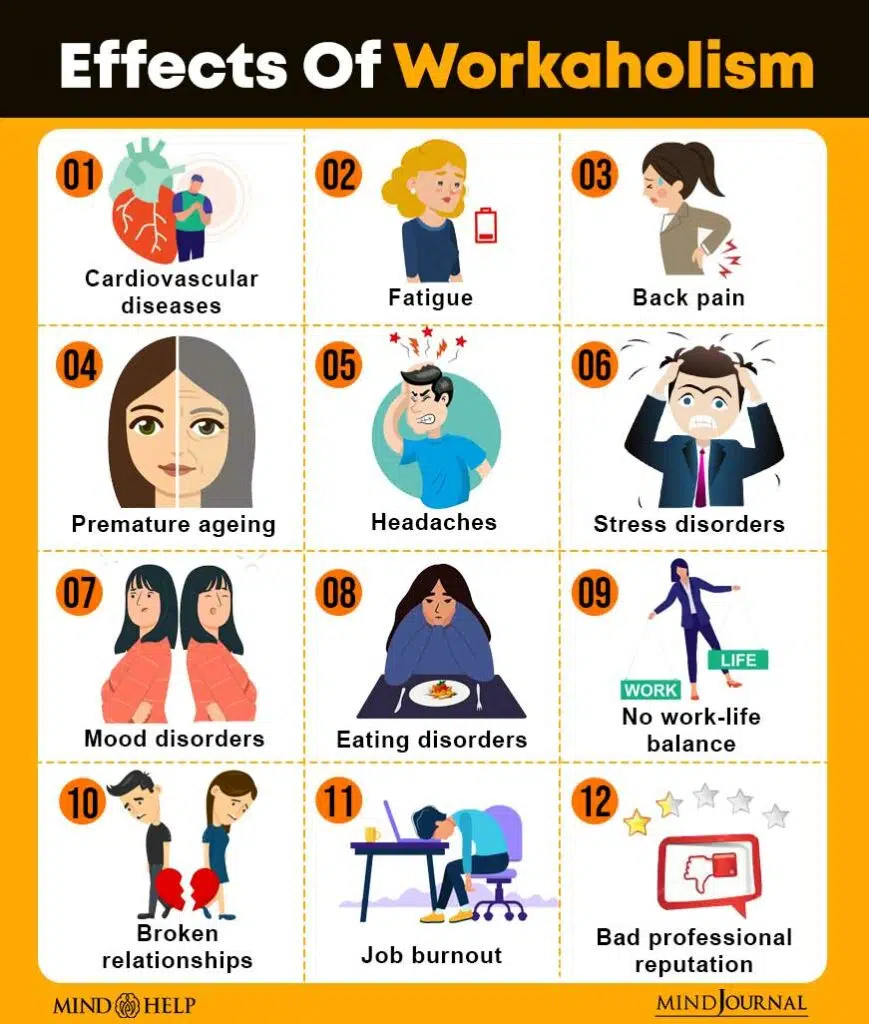
Workaholism is a very common behavioral disorder. But, if unaddressed, it causes severe harm [mfn] Shimazu, A., Schaufeli, W. B., & Taris, T. W. (2010). How does workaholism affect worker health and performance? The mediating role of coping. International journal of behavioral medicine, 17(2), 154–160. https://doi.org/10.1007/s12529-010-9077-x [/mfn] in the long run. A workaholic may suffer from:
1. Physical Disorders
Due to their erratic schedules and unhealthy lifestyles, people addicted to work often suffer from physical disorders, such as –
- Cardiovascular diseases [mfn] Veromaa, V., Kautiainen, H., & Korhonen, P. E. (2017). Physical and mental health factors associated with work engagement among Finnish female municipal employees: a cross-sectional study. BMJ open, 7(10), e017303. https://doi.org/10.1136/bmjopen-2017-017303 [/mfn]
- Fatigue [mfn] Shkoler, O., Rabenu, E., Vasiliu, C., Sharoni, G., & Tziner, A. (2017). Organizing the Confusion Surrounding Workaholism: New Structure, Measure, and Validation. Frontiers in psychology, 8, 1803. https://doi.org/10.3389/fpsyg.2017.01803 [/mfn]
- Back pain [mfn] Matsudaira, K., Shimazu, A., Fujii, T., Kubota, K., Sawada, T., Kikuchi, N., & Takahashi, M. (2013). Workaholism as a risk factor for depressive mood, disabling back pain, and sickness absence. PloS one, 8(9), e75140. https://doi.org/10.1371/journal.pone.0075140 [/mfn]
- Premature aging [mfn] InformedHealth.org [Internet]. Cologne, Germany: Institute for Quality and Efficiency in Health Care (IQWiG); 2006-. Depression: What is burnout? [Updated 2020 Jun 18]. Available from: https://www.ncbi.nlm.nih.gov/books/NBK279286/ [/mfn]
Read More About Premature Aging Here
2. Mental Disorders
Workaholics suffer from a wide range of mental disorders, such as –
- Stress disorders [mfn] Kim, S., Jeong, W., Jang, S. I., Park, E. C., & Park, S. (2021). Is Work Hour Mismatch Associated with Depression?. Safety and health at work, 12(1), 96–101. https://doi.org/10.1016/j.shaw.2020.09.009 [/mfn]
- Anxiety disorders [mfn] Allam, H. K., Helmy, M. S., El Badry, A. S., & Younis, F. E. (2021). Workaholism, sleep disorders, and potential e-learning impacts among Menoufia university staff during COVID-19 pandemic. Journal of public health research, 10(4), 2203. https://doi.org/10.4081/jphr.2021.2203 [/mfn]
- Mood disorders [mfn] Lee, D. W., Hong, Y. C., Seo, H. Y., Yun, J. Y., Nam, S. H., & Lee, N. (2021). Different Influence of Negative and Positive Spillover between Work and Life on Depression in a Longitudinal Study. Safety and health at work, 12(3), 377–383. https://doi.org/10.1016/j.shaw.2021.05.002 [/mfn]
- Depressive disorders
- Eating disorders [mfn] Lee, H. E., Kim, M. H., Choi, M., Kim, H. R., & Kawachi, I. (2021). Variability in daily or weekly working hours and self-reported mental health problems in Korea, Korean working condition survey, 2017. Archives of public health = Archives belges de sante publique, 79(1), 25. https://doi.org/10.1186/s13690-021-00545-z [/mfn]
Read More About Eating Disorders Here
They also experience behavioral problems, like volatile behavior [mfn] Spagnoli, P., & Molinaro, D. (2020). Negative (Workaholic) Emotions and Emotional Exhaustion: Might Job Autonomy Have Played a Strategic Role in Workers with Responsibility during the Covid-19 Crisis Lockdown?. Behavioral sciences (Basel, Switzerland), 10(12), 192. https://doi.org/10.3390/bs10120192 [/mfn], anger, irritable conduct, inadequate sleep [mfn] Keskin G. (2017). Today’s Public Health Issue: Workaholism. Iranian journal of public health, 46(2), 274–275. [/mfn], etc.
3. Impact On Social Life
Workaholics almost always suffer from a disrupted work-life balance. They do not have a personal life [mfn] Robinson, B. E., & Post, P. (1997). Risk of addiction to work and family functioning. Psychological reports, 81(1), 91–95. https://doi.org/10.2466/pr0.1997.81.1.91 [/mfn] and they frequently suffer from broken relationships [mfn] Shin, J., & Shin, H. (2020). Impact of Job Insecurity on Hotel Workers’ Workaholism and Work-Family Conflict in Korea. International journal of environmental research and public health, 17(21), 7783. https://doi.org/10.3390/ijerph17217783 [/mfn]. This compromises their quality of life [mfn] Azevedo, W. F., & Mathias, L. (2017). Work addiction and quality of life: a study with physicians. Einstein (Sao Paulo, Brazil), 15(2), 130–135. https://doi.org/10.1590/S1679-45082017AO3960 [/mfn].
4. Impact On Career
Studies [mfn] Spagnoli, P., Balducci, C., Scafuri Kovalchuk, L., Maiorano, F., & Buono, C. (2018). Are Engaged Workaholics Protected against Job-Related Negative Affect and Anxiety before Sleep? A Study of the Moderating Role of Gender. International journal of environmental research and public health, 15(9), 1996. https://doi.org/10.3390/ijerph15091996 [/mfn] increasingly show that organizational surveys highlight the desire to employ ‘work engaged’ individuals and not ‘workaholic’ people. This is because workaholics are seen as organizational liabilities [mfn] Scheen A. J. (2013). (workaholism): la dépendance au travail, une autre forme d’addiction [Workaholism, another form of addiction]. Revue medicale de Liege, 68(5-6), 371–376. [/mfn] who engage in negative work [mfn] ABBOTT, B. C., BIGLAND, B., & RITCHIE, J. M. (1952). The physiological cost of negative work. The Journal of physiology, 117(3), 380–390. https://doi.org/10.1113/jphysiol.1952.sp004755 [/mfn], thereby experiencing job burnout and low productivity in the long run. This may negatively impact workaholics’ professional reputations and careers.
Diagnosis Of Workaholism
At a clinical level, workaholism can be measured by a number of scales, such as:
- Workaholism Battery (WorkBAT)
- Work Addiction Risk Test (WART [mfn] Ravoux, H., Pereira, B., Brousse, G., Dewavrin, S., Cornet, T., Mermillod, M., Mondillon, L., Vallet, G., Moustafa, F., & Dutheil, F. (2018). Work Addiction Test Questionnaire to Assess Workaholism: Validation of French Version. JMIR mental health, 5(1), e12. https://doi.org/10.2196/mental.8215 [/mfn] )
- Bergen Work Addiction Scale (BWAS [mfn] Lichtenstein, M. B., Malkenes, M., Sibbersen, C., & Hinze, C. J. (2019). Work addiction is associated with increased stress and reduced quality of life: Validation of the Bergen Work Addiction Scale in Danish. Scandinavian journal of psychology, 60(2), 145–151. https://doi.org/10.1111/sjop.12506 [/mfn] )
Treatment Of Workaholism
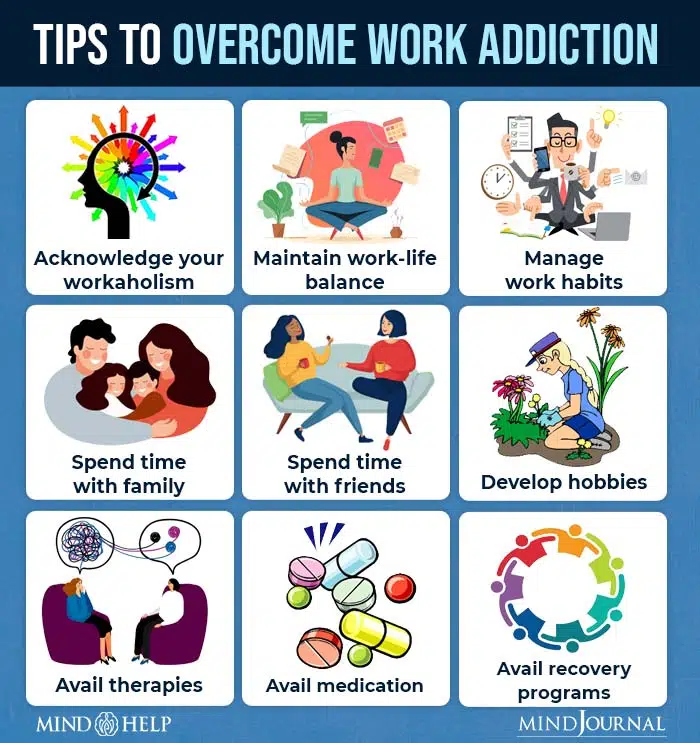
The first step towards managing workaholism is acknowledging that you have the symptoms of workaholism. The earlier you acknowledge that you are slipping into work addiction, the better you can recover from it by the help of therapies, medications, and other measures.
A 2018 study [mfn] Molino, M., Cortese, C. G., & Ghislieri, C. (2018). Daily Effect of Recovery on Exhaustion: A Cross-Level Interaction Effect of Workaholism. International journal of environmental research and public health, 15(9), 1920. https://doi.org/10.3390/ijerph15091920 [/mfn] lists the steps in workaholism treatment as “psychological detachment, relaxation, mastery, and control”. Firstly, workaholics must reframe their work-related thoughts. Secondly, they must separate their personal sense of worth from work performance. Lastly, to refrain from work demands, they should avoid working in their leisure time and try off-job activities. This can help them control their work-related impulses, nurture a more fulfilling work ethic [mfn] Di Stefano, G., & Gaudiino, M. (2018). Differential Effects of Workaholism and Work Engagement on the Interference Between Life and Work Domains. Europe’s journal of psychology, 14(4), 863–879. https://doi.org/10.5964/ejop.v14i4.1626 [/mfn] and experience positive emotions.
Common treatment approaches for this behavioral disorder includes –
1. Therapy
Therapies [mfn] Field, T., Quintino, O., Henteleff, T., Wells-Keife, L., & Delvecchio-Feinberg, G. (1997). Job stress reduction therapies. Alternative therapies in health and medicine, 3(4), 54–56. [/mfn], such as cognitive behavioral therapy (CBT) [mfn] Magill, M., Tonigan, J. S., Kiluk, B., Ray, L., Walthers, J., & Carroll, K. (2020). The search for mechanisms of cognitive behavioral therapy for alcohol or other drug use disorders: A systematic review. Behaviour research and therapy, 131, 103648. https://doi.org/10.1016/j.brat.2020.103648 [/mfn] , family therapy [mfn] Sheidow, A. J., Henry, D. B., Tolan, P. H., & Strachan, M. K. (2014). The Role of Stress Exposure and Family Functioning in Internalizing Outcomes of Urban Families. Journal of child and family studies, 23(8), 1351–1365. https://doi.org/10.1007/s10826-013-9793-3 [/mfn], rational emotive behavior therapy (REBT) [mfn] Iftene, F., Predescu, E., Stefan, S., & David, D. (2015). Rational-emotive and cognitive-behavior therapy (REBT/CBT) versus pharmacotherapy versus REBT/CBT plus pharmacotherapy in the treatment of major depressive disorder in youth; a randomized clinical trial. Psychiatry research, 225(3), 687–694. https://doi.org/10.1016/j.psychres.2014.11.021 [/mfn] and metacognitive therapy [mfn] De Dominicis, S., Troen, M. L., & Callesen, P. (2021). Metacognitive Therapy for Work-Related Stress: A Feasibility Study. Frontiers in psychiatry, 12, 668245. https://doi.org/10.3389/fpsyt.2021.668245 [/mfn]. can be availed by workaholics to recover from their work addiction. Studies [mfn] Malinowska, D., Staszczyk, S., & Tokarz, A. (2015). Pracoholizm – wskazania dotyczące diagnozy oraz przegląd działań interwencyjnych [Workaholism – indications for diagnosis and review of interventions]. Medycyna pracy, 66(1), 71–83. [/mfn] show that such therapies induce psychological resilience, positive thinking, relaxation, and empathy in people addicted to work. Other therapies like art therapy and group support can also be helpful.
Read More About Therapy Here
2. Recovery Programs
There is no specific recovery program for work addiction, but mindfulness techniques are considered helpful for workaholics. These help in reducing unpleasant work-related thoughts and increase positive feelings of mindfulness, peace, and social belongingness [mfn] Prinz, P., Hertrich, K., Hirschfelder, U., & de Zwaan, M. (2012). Burnout, depression and depersonalisation–psychological factors and coping strategies in dental and medical students. GMS Zeitschrift fur medizinische Ausbildung, 29(1), Doc10. https://doi.org/10.3205/zma000780 [/mfn]. Such approaches include meditation awareness training (MAT) [mfn] Van Gordon, W., Shonin, E., Dunn, T. J., Garcia-Campayo, J., Demarzo, M., & Griffiths, M. D. (2017). Meditation awareness training for the treatment of workaholism: A controlled trial. Journal of behavioral addictions, 6(2), 212–220. https://doi.org/10.1556/2006.6.2017.021 [/mfn], motivational interviewing [mfn] Bischof, G., Bischof, A., & Rumpf, H. J. (2021). Motivational Interviewing: An Evidence-Based Approach for Use in Medical Practice. Deutsches Arzteblatt international, 118(7), 109–115. https://doi.org/10.3238/arztebl.m2021.0014 [/mfn], etc.
3. Medications
Recent studies have linked workaholism to occupational [mfn] D’Auria D. (1995). Occupational medicine. Occupational medicine (Oxford, England), 45(4), 171–172. https://doi.org/10.1093/occmed/45.4.171 [/mfn] and environmental medication [mfn] Baker, B., Kesler, D., & Guidotti, T. (2020). Occupational and Environmental Medicine: Public Health and Medicine in the Workplace. American journal of public health, 110(5), 636–637. https://doi.org/10.2105/AJPH.2020.305625 [/mfn]. Researchers [mfn] Pflanz, S. E., & Ogle, A. D. (2006). Job stress, depression, work performance, and perceptions of supervisors in military personnel. Military medicine, 171(9), 861–865. https://doi.org/10.7205/milmed.171.9.861 [/mfn] have also observed that workaholics can benefit from certain medications [mfn] Cossin, T., Thaon, I., & Lalanne, L. (2021). Workaholism Prevention in Occupational Medicine: A Systematic Review. International journal of environmental research and public health, 18(13), 7109. https://doi.org/10.3390/ijerph18137109 [/mfn], such as anti-anxiety drugs [mfn] Koutsimani, P., Montgomery, A., & Georganta, K. (2019). The Relationship Between Burnout, Depression, and Anxiety: A Systematic Review and Meta-Analysis. Frontiers in psychology, 10, 284. https://doi.org/10.3389/fpsyg.2019.00284 [/mfn], antidepressants [mfn] Maslach, C., & Leiter, M. P. (2016). Understanding the burnout experience: recent research and its implications for psychiatry. World psychiatry : official journal of the World Psychiatric Association (WPA), 15(2), 103–111. https://doi.org/10.1002/wps.20311 [/mfn], etc.
4.Self-help Techniques
Self-help techniques can be practiced at both individual and organizational levels to combat workaholism.
For individuals:
Here are a few effective self-help coping strategies that can empower you to overcome the symptoms and build healthier habits:
- Start by accepting and acknowledging that you may be addicted to work
- Be intentional about your work habits
- Set deadlines at work and communicating openly with your colleagues
- Develop healthy financial habits to avoid money problems
- Limit work-related interactions when you are away from the workplace
- Spend quality time with your family and friends
- Practice exercise, yoga, meditation, etc. for mental well-being
- Maintain healthy eating and sleeping schedules [mfn] Siegrist, J., & Li, J. (2018). Work Stress and the Development of Chronic Diseases. International journal of environmental research and public health, 15(3), 536. https://doi.org/10.3390/ijerph15030536 [/mfn]
- Engage in hobbies or activities that make you happy
- Consult a therapist, if you feel overwhelmed by your work life
Read More About Meditation Here
For organizations:
The work culture of a company may also fuel workaholism. At the organizational level, work addiction can be corrected by generating employee-feedback [mfn] Dutheil, F., Charkhabi, M., Ravoux, H., Brousse, G., Dewavrin, S., Cornet, T., Mondillon, L., Han, S., Pfabigan, D., S Baker, J., Mermillod, M., Schmidt, J., Moustafa, F., & Pereira, B. (2020). Exploring the Link between Work Addiction Risk and Health-Related Outcomes Using Job-Demand-Control Model. International journal of environmental research and public health, 17(20), 7594. https://doi.org/10.3390/ijerph17207594 [/mfn]. The suggestions can then be incorporated in the organizational work culture to improve employee productivity and well-being.
Here are some other ways business owners can address employees’ workaholism:
- Provide employees balanced and flexible work schedules
- Provide them with paid holidays, so that they can spend time with their friends and family
- Provide recovery programs and workshops that focus on physical and psychological well-being at the workplace
- Make opportunities for employees to engage in interactive extracurricular activities
- Advocate a company culture that encourages effective communication between the employees and the employers at all levels
- Encourage employees and employers to maintain a healthy work-life balance
Need For Work-life Balance
Work-life balance is the opposite of work addiction or unemployment. A person with a healthy work-life balance [mfn] Gragnano, A., Simbula, S., & Miglioretti, M. (2020). Work-Life Balance: Weighing the Importance of Work-Family and Work-Health Balance. International journal of environmental research and public health, 17(3), 907. https://doi.org/10.3390/ijerph17030907 [/mfn] experiences a sense of accomplishment and fulfillment through work. It improves their physical, psychological, and social well-being. In workaholics, work-life balance is the key to addressing job burnout, low productivity, and other drawbacks.
You can achieve work-life balance in a number of ways, such as:
- Prioritizing your work commitments
- Learning to say “No” to responsibilities you can’t fulfill
- Communicating openly with your family and colleagues about your work life
- Developing a support system at work and at home
Takeaway
Workaholism is an unrecognized and under-diagnosed medical condition. But, it is a very common addiction. If left unaddressed, it can lead to severe physical and mental illnesses in the long run. It can also disrupt your interpersonal relationships as well as other aspects of your personal life. A workaholic can easily recover through self-help strategies, therapies, medication, and recovery programs.
Workaholic At A Glance
- Workaholism is the compulsive need to work hard for long hours.
- Work addiction is not a recognized medical condition, but it has negative consequences.
- Workaholism symptoms involve job burnout, fatigue, broken relationships, working to escape negative situations and emotions, etc.
- It is caused by personal, organizational, social, and cultural factors.
- Workaholics overwork at the cost of physical and mental wellbeing, social relationships, etc.
- Workaholism can be easily addressed at both individual and organizational levels.
- It can be treated by therapies, medication, and coping techniques that aim at a healthy work-life balance.
Frequently Asked Questions (FAQs)
1. Who is a workaholic?
Someone who is addicted to work is called a workaholic. He/she mostly suffer from the compulsive urge to work hard for long hours.
2. Is workaholism a disorder?
Workaholism is a behavioral disorder centered on work. Work addiction is considered work-related impulse control or stress disorder, obsessive compulsive personality disorder (OCPD), or obsessive compulsive disorder (OCD).
3. How do I break my work addiction?
Work addiction can be easily managed by self-help techniques, therapy, and/or medication. To make recovery easier, try acknowledging your work-related problems. Communicate freely about the workload and aim at a healthy work-life balance.
4. How does workaholism affect a family?
Work addiction has been linked to broken relationships, divorces, adultery, etc. Children with workaholic parents are more vulnerable to parentification, neglect, mental disorders, and substance abuse.
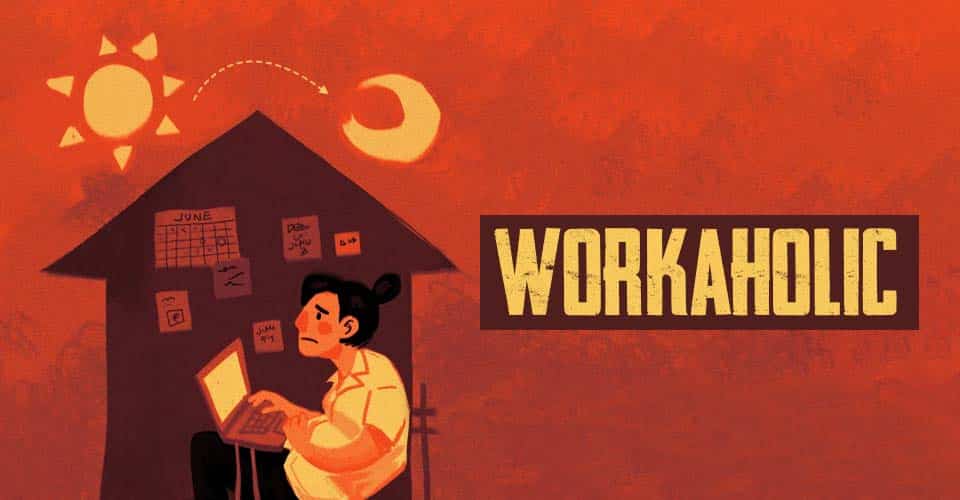









Leave a Reply